Everything discussed in the first part of my series will lay the foundation for each subsequent coverage. If you have not read it, I encourage you to do so here.
Remember our rule from last time? The number after "Cover" points to the number of deep zones being occupied by the defense. In this case, that means Cover 2 is a two deep zone defense that can either be played as a man or zone defense underneath and offers flexibility in its zone alignments.
Let us take a look at a play from Week 1 against the Buffalo Bills. The Ravens lead 17-0 with 13:14 to go in the second quarter. The Bills have the ball on their own 25 yard line.
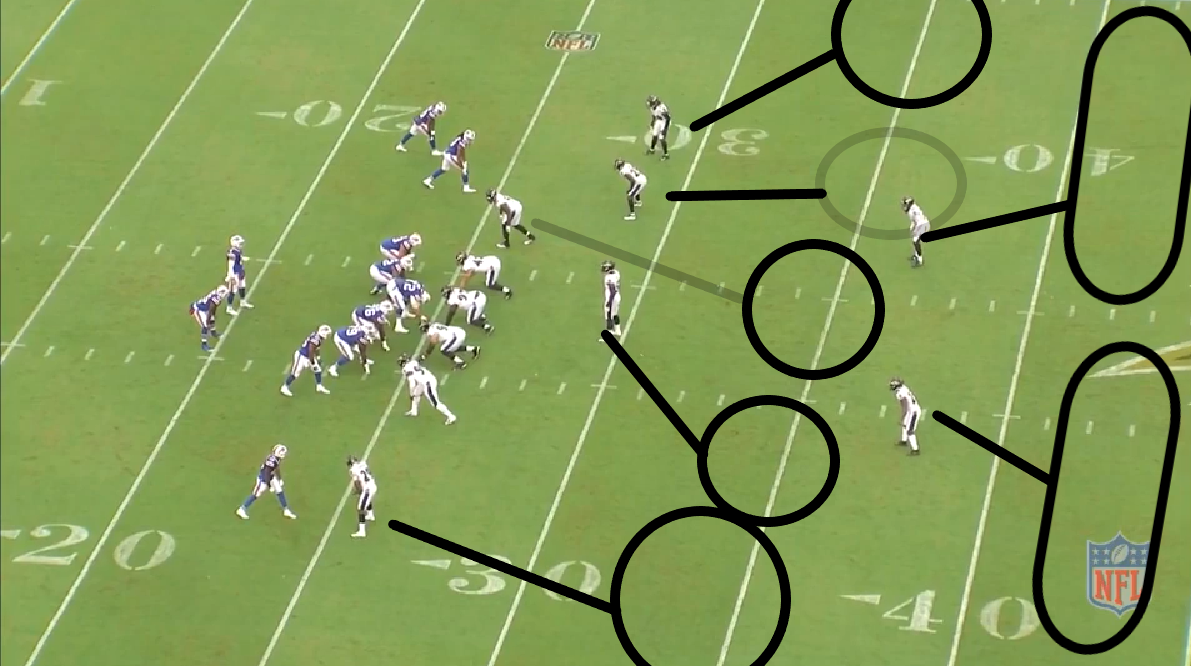
The Ravens are going to show a bit of a deceptive look that will appear to be Cover 2 man by showing a fifth down lineman to rush the passer. However, in Cover 2, there will always be four pass rushers and seven players in coverage.
The two outside cornerbacks will play with outside leverage to funnel all routes inside to the strength of the coverage. Any inside breaking routes will be sniffed out by the linebackers and any vertical concepts will be taken by the safeties.
The cornerbacks can align from either press or they can align from off man coverage. If a cornerback aligns in press, he will funnel the route inside and then immediately begin to sink to his landmark in the flat, about 10-12 yards off the line of scrimmage. If the cornerback takes an off man approach, he will take a flat footed read through the three step drop to quickly work downhill on any quick breaking routes, then get into his backpedal to work to the flat once this has been cleared. The cornerback in either case will cushion against any fade or corner routes that a safety will need time to work over the top of.
The WILL and SAM (in this case, the nickel cornerback) linebackers will work to drop into a seam-hook drop, at a depth of 10-12 yards. The MIKE will drop into a middle vertical seam zone at a depth of 10-12 yards in a standard Cover 2 (more on this clarification later).
The safeties will start at a depth of roughly 15 yards and align inside of the cornerbacks. The role of the safety is two-fold. Against the pass, they are obviously the last line of defense and cover the two deep halves. However, against the run, the safeties will defend the "alley" between the tackle/in-line tight end and the cornerback. This requires that the safeties read their run/pass keys and work downhill against the run if their key shows run (more on that later). Assuming the run/pass key shows pass, the safeties will then work to a depth of about 18 yards and hit their zone landmark at the top of the numbers. The goal is to always be inside of the number one receiver. They will play "top-down," which means that they will handle any vertical routes in their zone and then work down on each other route.
Let's see how this play unfolds:
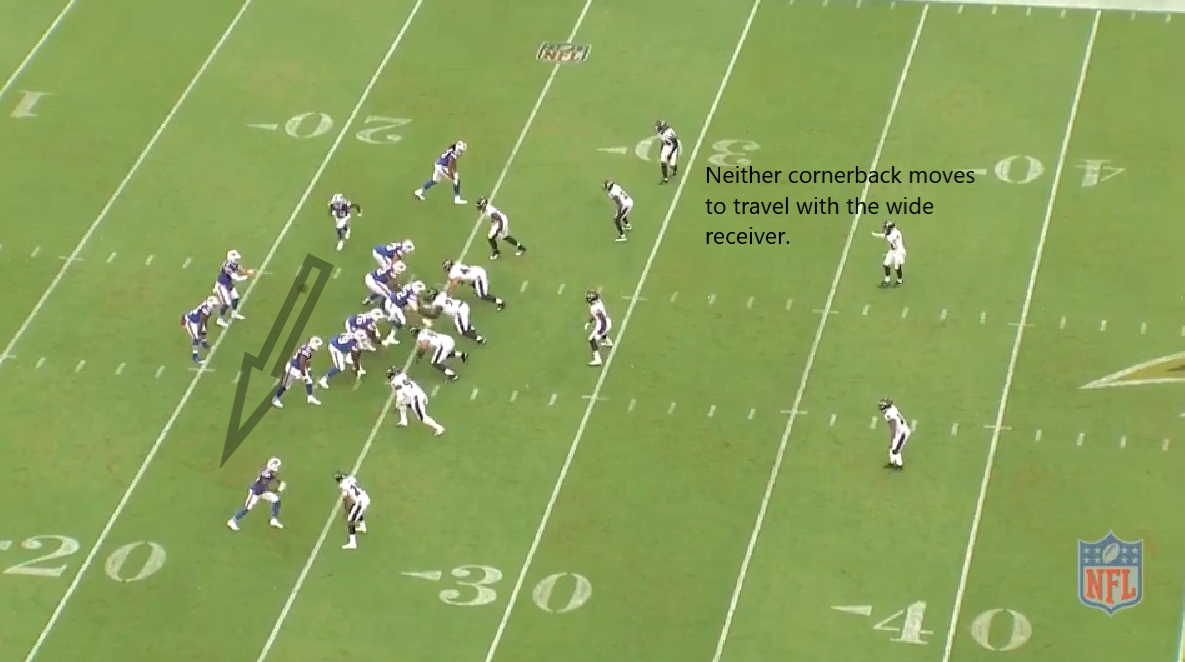
I talked previously about how offenses will use "window dressings" to sniff out zone or man coverage. In this case, the Bills use a jet-sweep with no cornerback traveling across the formation. This immediately alerts the Bills to zone coverage. With two deep safeties, the Bills can assume this is Cover 2.
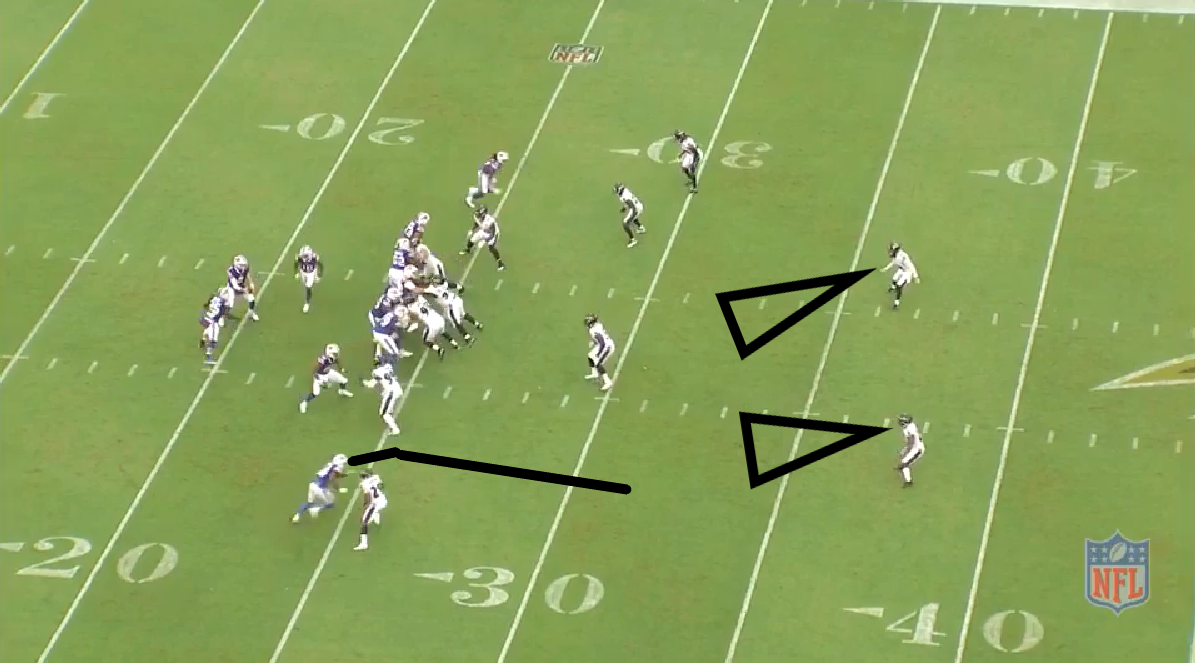
This is what I was talking about when I referred to run/pass keys for the safeties. Both safeties will read the number one receiver and watch the wide receiver's release. A hard vertical stem would signal that the Bills are going to run. However, an inside release signals to both safeties that this is a pass play with play action.
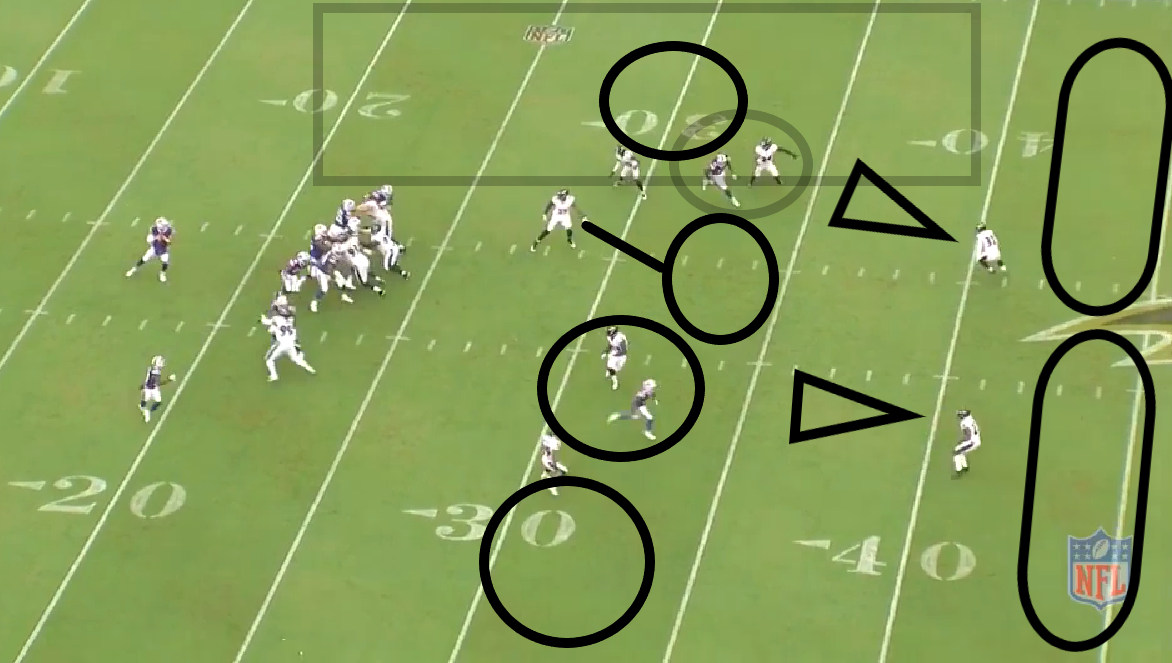
Both safeties begin to work to their landmark at the top of the numbers. Both cornerbacks forced an inside release as the linebackers, and Tavon Young, work to their landmarks underneath. However, I really want you to take a look at Brandon Carr. Normally, Carr would be responsible for the flat and cushioning against the fade/corner route, but if we look at the large box, there is no threat to the flat. Carr shows veteran savvy and continues to look for work and will actually carry his man through his inside release.
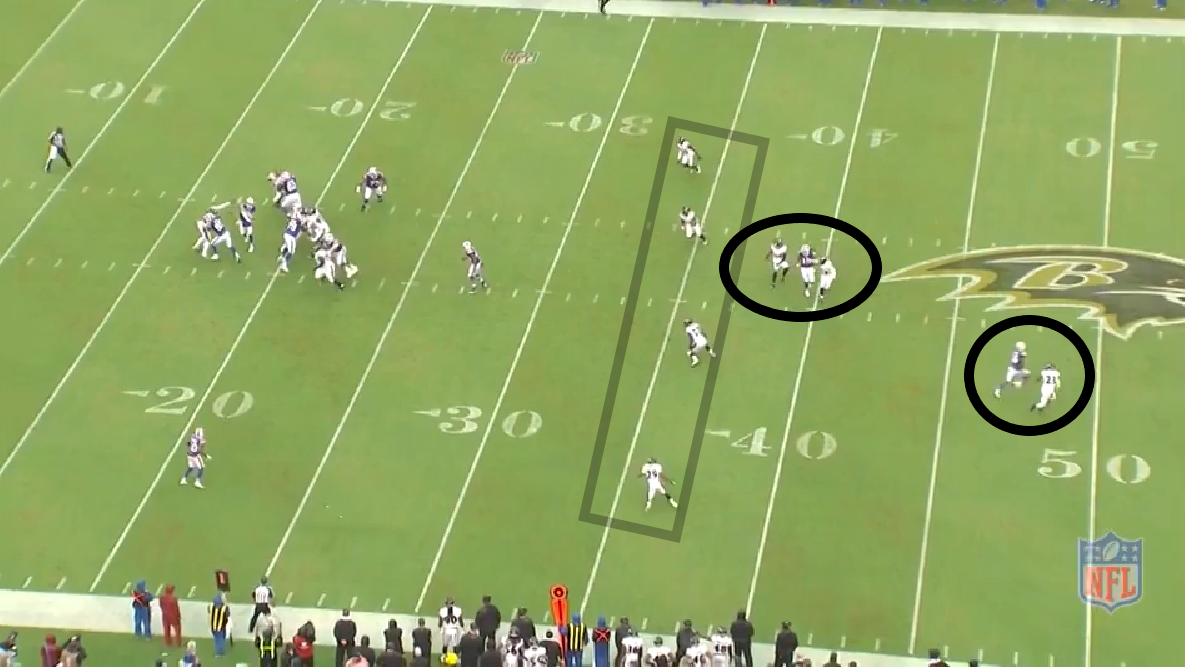
The Bills wide receivers are locked up deep and the Ravens have a large tent at the sticks to force a dump off with minimal yards after the catch. Nathan Peterman ultimately dumps the ball off for a four yard gain.
Cover 2 vs a Slot Formation
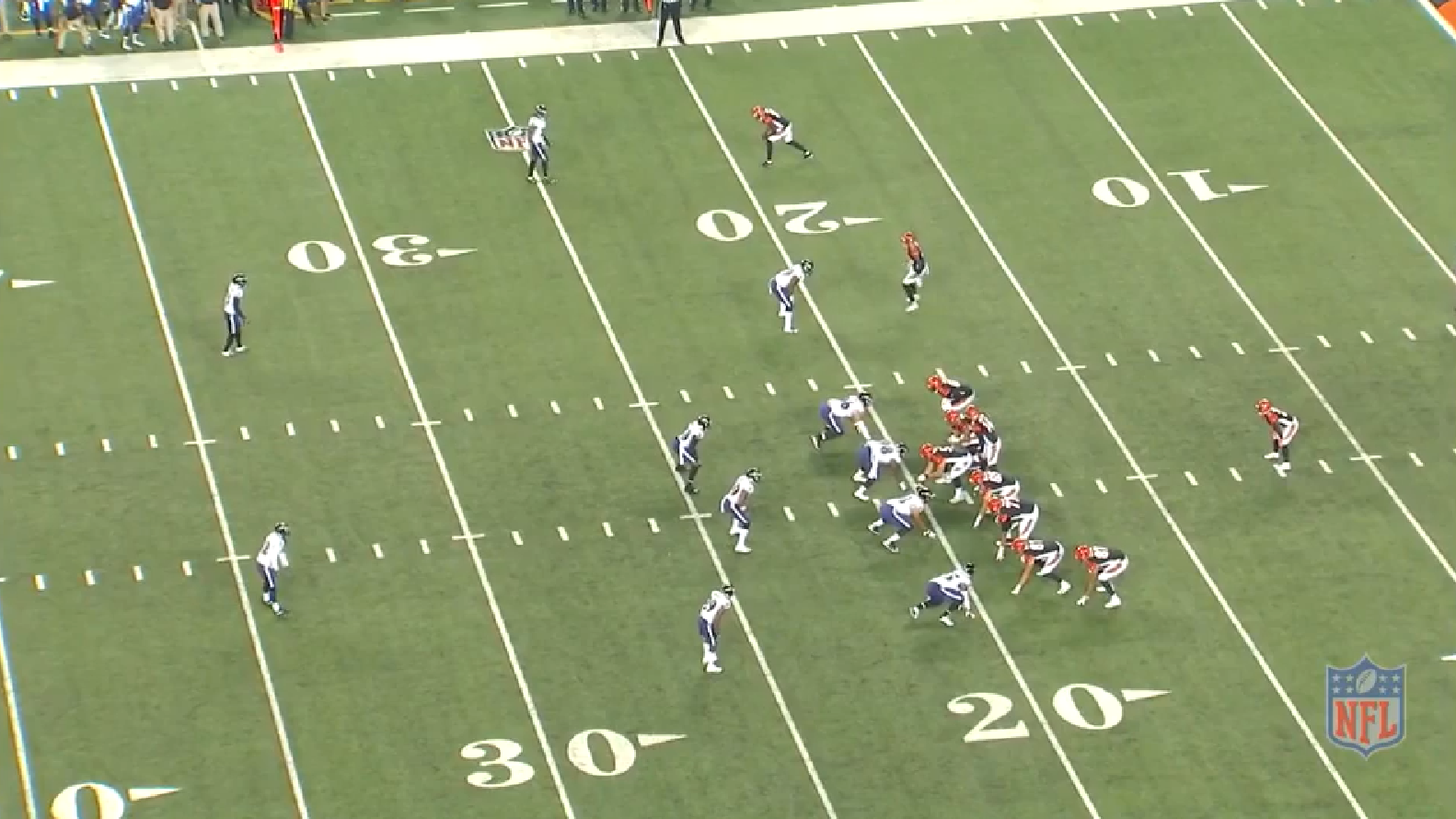
The Ravens actually showed a pre-snap look of Cover 2 before changing it just before the snap, but this pre-snap alignment will show exactly what I need.
In Cover 2, the cornerbacks do no travel with their wide receiver. That means that even if the strong side of the formation does not have a wide receiver, the cornerback will still play out to that side. In this case, that is Marlon Humphrey. This alters the landmark of the strong safety, Eric Weddle, as well. Instead of hitting a landmark at the top of the numbers, Weddle will actually work to stay inside of the furthest tight end to his side of the formation. However, on the flip side, Jefferson will still work to the top of the numbers and align over the slot receiver.
This will put a lot of strain onto Marlon Humphrey if the Cincinnati Bengals call a run play. Humphrey is the first defender on the edge of the strong side of the formation and will need to be able to hold the edge against a tight end or a kicking guard. Buckle up that chin strap, kid, because you are gonna be in for a ride.
In true Cover 2, Judon would actually be inside the tackle box and not aligning over the slot receiver.
The Chiefs lead the Jaguars by a score of 7-2 in the first quarter with 1:50 remaining. The Chiefs have the ball first down from the Jaguars 3-yard line.
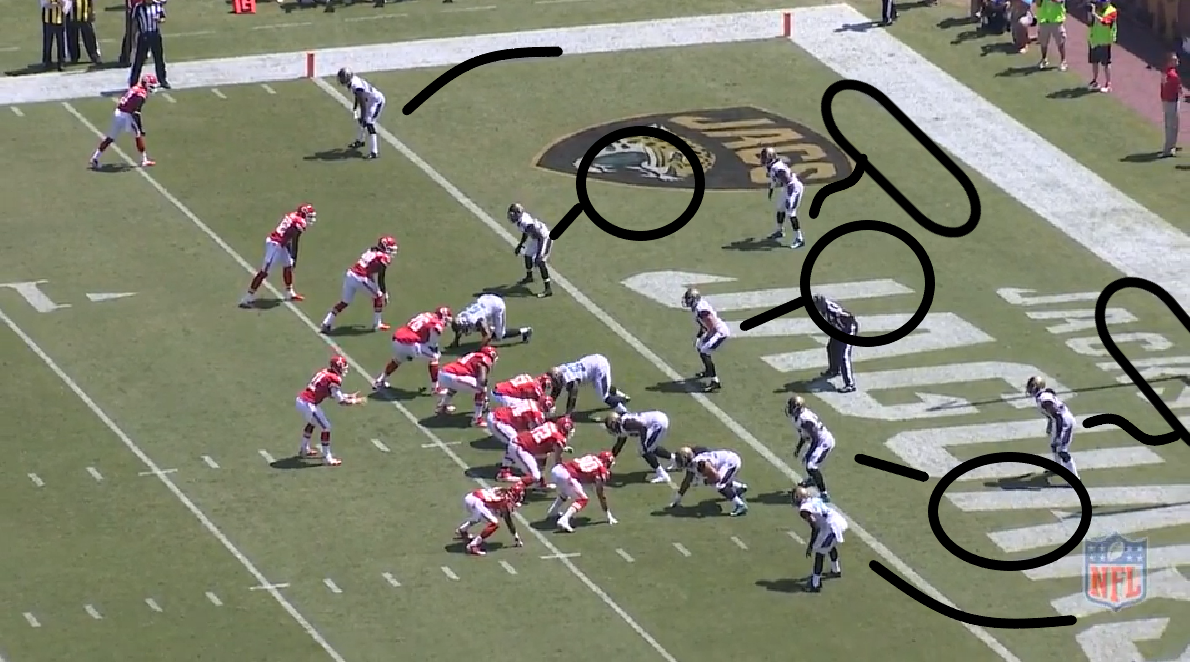
Cover 2 in a goal to go situation is going to be a little different than Cover 2 in a more open field setting. Due to the back of the end zone and the condensed space that the offense has to work with, the drops from the linebackers are going to be more shallow and the drops of the safeties is going to be non-existent. The cornerbacks will also take a little bit of a different approach by working immediately outside to cushion against the fade/corner route and protecting the flat.
The safeties will take a flat footed read because there is no need to backpedal. They will work from top-down and drive on any shallow passing routes while using the backline as an extra defender against any crossing or deep in routes.
The SAM and WILL linebacker will again take the hook-seam zone. The MIKE linebacker will open his hips to the strong side of the formation and take any vertical seam routes.
The cornerbacks will immediately widen and cushion against any potential fade/corner route. However, while they are backpedaling into their drop, they will keep their backs to the sideline to be ready to drive on any shallow routes.
Let us see how this play unfolds:
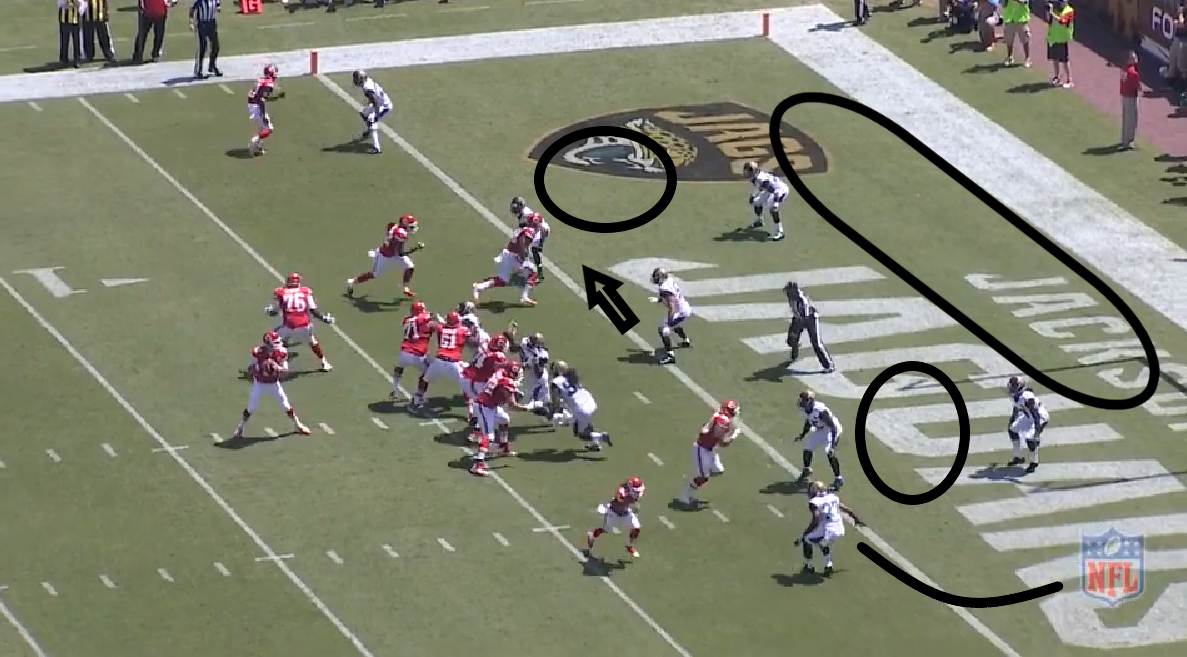
Both safeties take a flat footed approach while the MIKE linebacker opens his hips to the strong side of the passing formation. The left cornerback on the bottom of the screen widens to protect the flat and cushions against the fade/corner route.
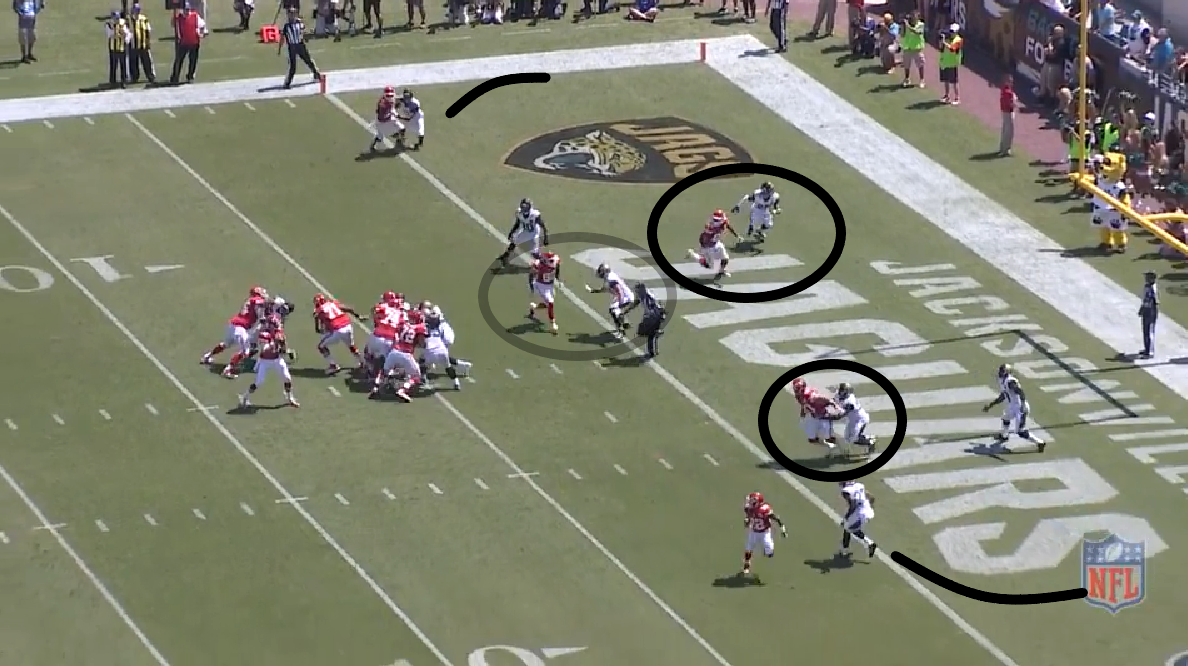
Both cornerbacks keep their backs to the sideline. The MIKE linebacker picks up the crossing receiver over the shallow middle while the SAM linebacker picks up the tight end. The free safety is late working across the middle as Junior Hemingway finds the soft spot in the middle of the defense.
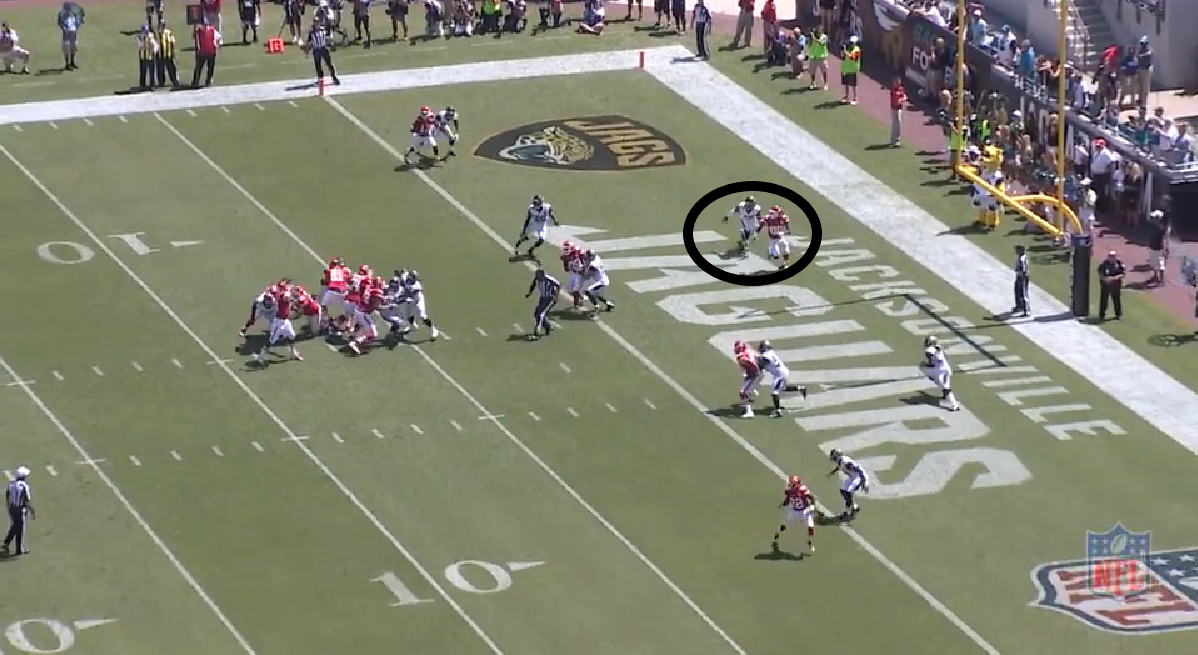
Alex Smith throws a three yard touchdown pass to Junior Hemingway in the soft spot of the Cover 2 defense.
The Tampa 2The Tampa 2 defense was originally invented by the Pittsburgh Steelers Steel Curtain defense of the 1970's under Chuck Noll and Bud Carson. However, the name "Tampa 2" came to fruition because of the success of the Tampa Bay Buccaneers in the 90's and early 00's under then head coach Tony Dungy and defensive coordinator Monte Kiffin. The Tampa 2 was the base defense of the 2002 Tampa Bay Buccaneers defense that would lead the NFL in total scoring, total yards, interceptions (40 between the regular season and postseason), and passer rating allowed (48.5).
The Tampa 2 defense was actually what I had hoped the Ravens would trend toward when they drafted CJ Mosley and Timmy Jernigan in the first two rounds of the 2014 draft, but that did not come to fruition. However, that does not mean that the Ravens do not utilize the Tampa 2 defense. In fact, the Tampa 2 is the most common variation of the Cover 2 defense that will be used on Sundays.
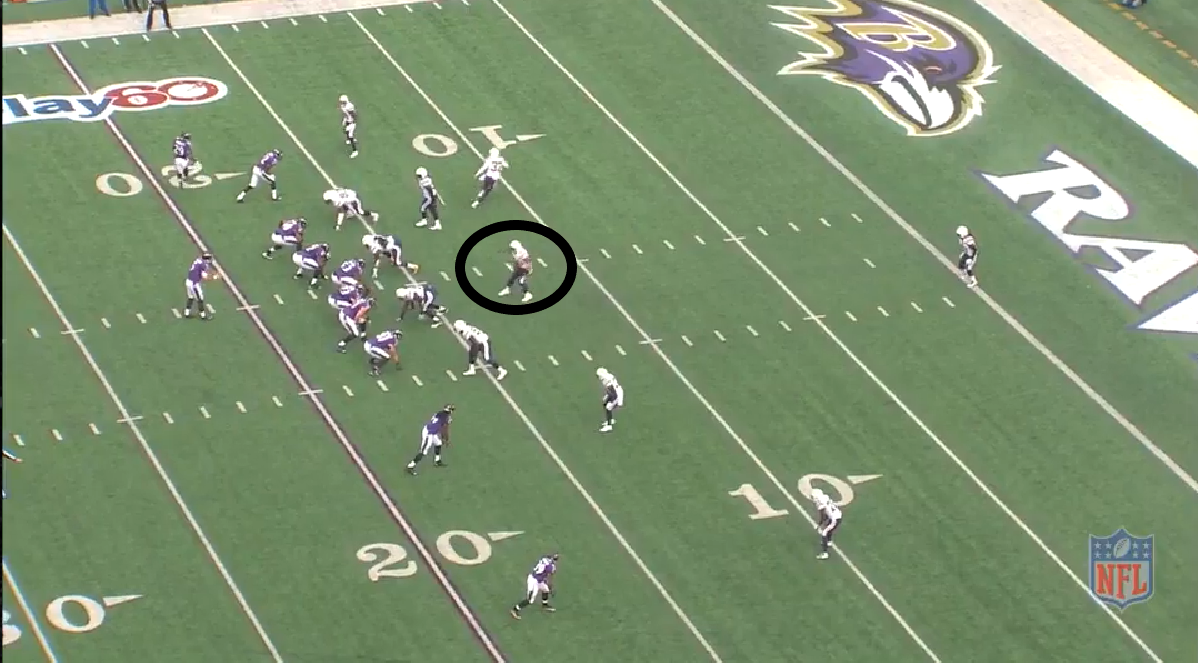
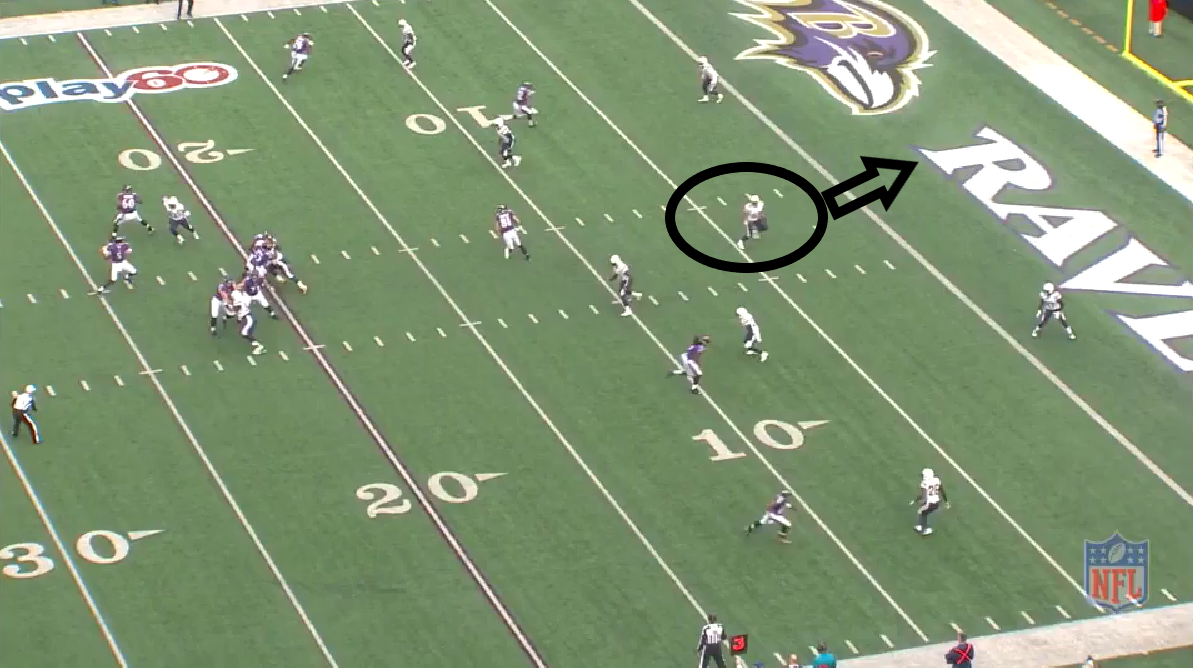
This will be a rather short and quick look because we are solely going to focus onto the MIKE linebacker. All the previous rules apply, with the exception of a wrinkle employed by the MIKE linebacker.
The MIKE linebacker will not take his usual middle hook drop and settle in at a depth of 10-12 yards. Instead, the MIKE will open his hips to the strong side of the formation and work his way down the field and create a three deep zone look. However, the MIKE must have the hip flexibility and fluidity to change direction and work back to the weak side of the formation if the quarterback begins to read that way.
For those interested in watching the full play: Week 14 against the San Diego Chargers. The Ravens have the ball on the San Diego 16 on 3rd and 13. The score is tied 0-0 in the first.
Facing 3rd and 10 from their own 37, the Ravens have the ball in the fourth with the score tied 9-9 against the Cleveland Browns.
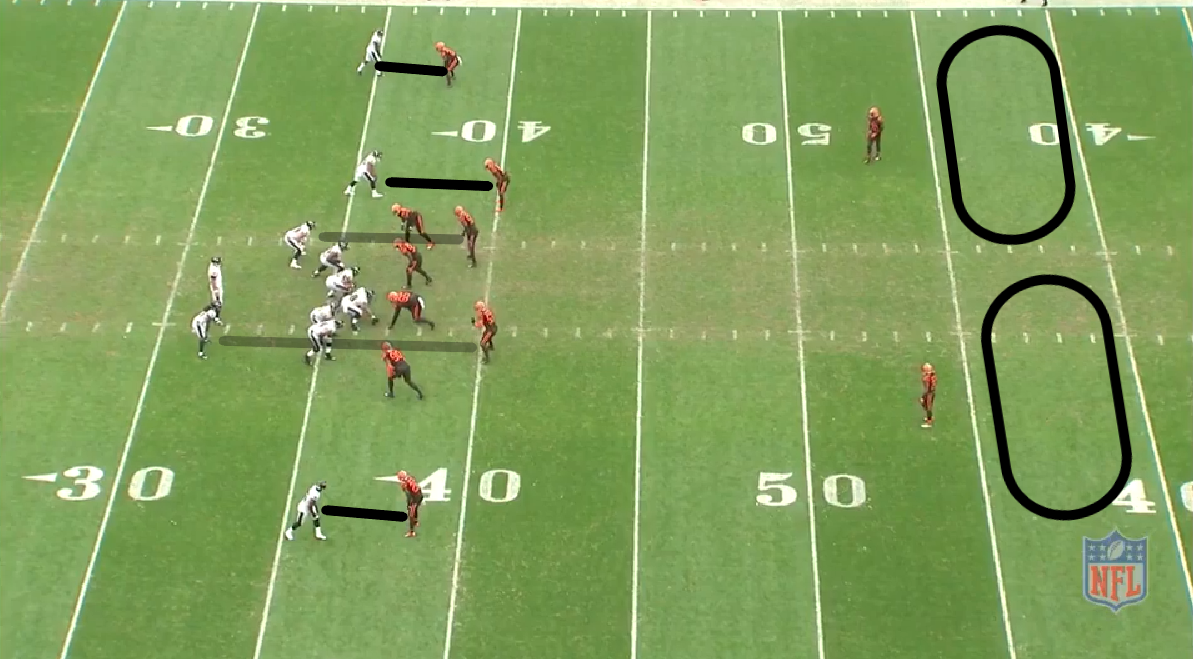
Cover 2 Man will take a similar look as that of Cover 2 zone coverage from the pre-snap. However, instead of the corners aligning with outside leverage to funnel routes to the inside, the corners will align with inside leverage to pinch the receivers to the sideline. Without any pre-snap movement, this is one area where a quarterback can key into the coverage.
The safeties will still use their same run/pass keys and work to their landmarks at the top of the numbers about 18 yards off the ball. This is the ideal position to drive downhill on any in or out breaking routes while also allowing the safeties to work over the top of any fade routes or seam routes.
Underneath, the cornerbacks and linebackers will take an aggressive approach to their coverage. Due to the fact that their is safety help over the top, the coverage will play what is called a "trail" technique. The defender will sit at the inside hip of the wide receiver and run from there. This allows the defender to disrupt the wide receiver at the top of the stem and aggressively undercut throws.
Let us see how this play unfolds.
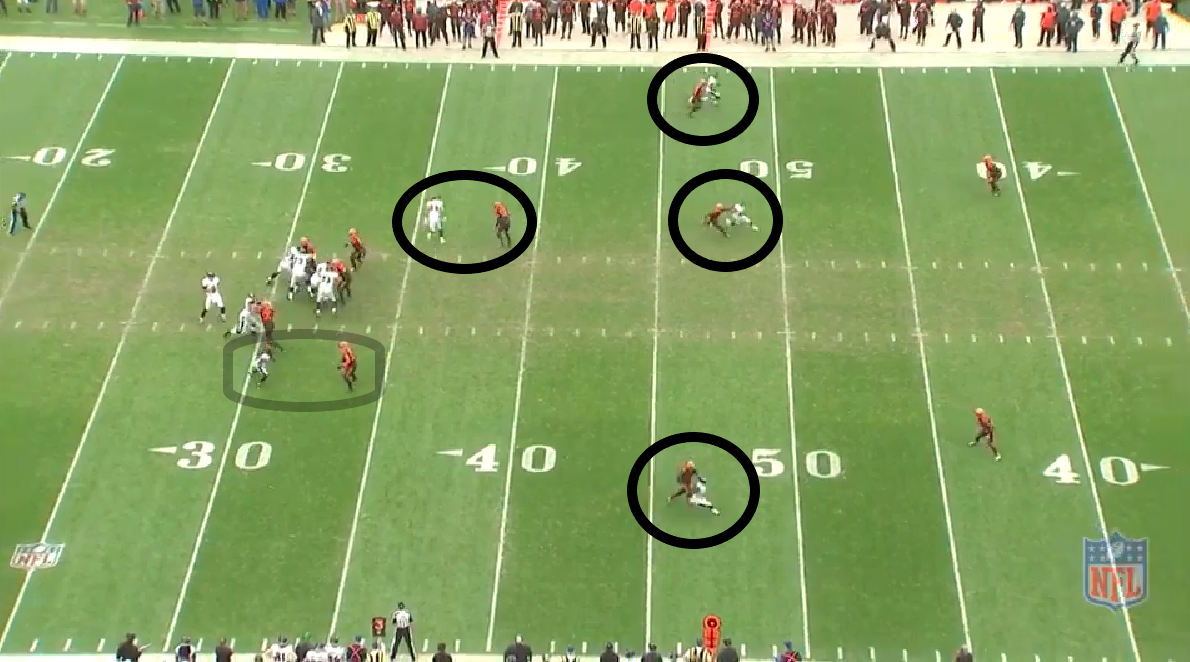
Any throw by Joe Flacco at this point will be undercut and intercepted by a cornerback or will be floated over the top to be intercepted by a safety. All cornerbacks are playing with trail technique by defending the inside hip of the wide receiver.
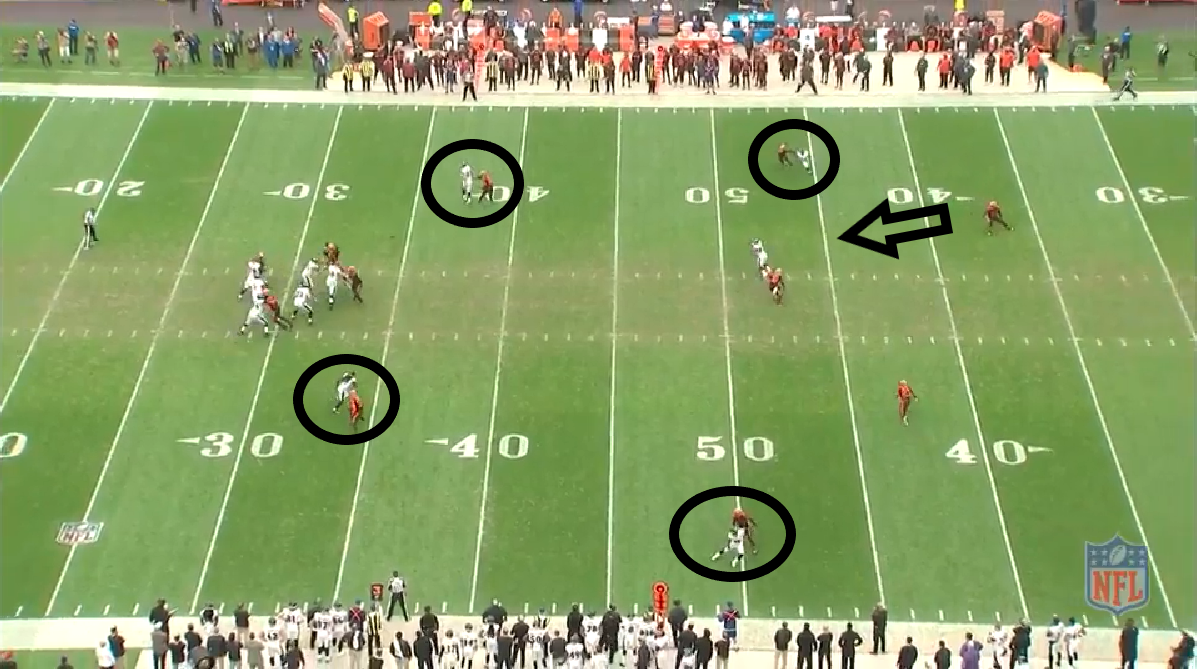
The post route threatened by John Brown freezes the strong safety over the top and forces him to a depth of over 20 yards. This means that when Willie Snead snaps his route off to the outside, taking advantage of the aggressive positioning by the cornerback, the strong safety cannot break downhill in time to defend Snead. However, Joe Flacco floats the pass well overhead and misses an easy conversion.
The Strengths and Weaknesses of Cover 2We discussed some of the strengths of Cover 2 above. The main strengths lie in the ability to defend short routes with five men underneath while also putting a tent over the top with two deep safeties in a zone look. For offenses that often threaten the seam, the Tampa 2 provides a MIKE linebacker to take some of the stress off of the linebackers. In Cover 2 man, the defense can aggressively take away throws underneath because of safety help over the top.
But for the weaknesses of Cover 2, I am going to refer you to an excellent read by Andy Benoit of Sports Illustrated, who does an excellent breakdown of how teams are now beating the Cover 2 defense.
This is the third part in a multi-part series detailing coverages that are employed by NFL secondaries.
Part 1: Football for Dummies: Press Man Coverage vs Off Man Coverage
Part 2: Football for Dummies: Cover 1
Remember our rule from last time? The number after "Cover" points to the number of deep zones being occupied by the defense. In this case, that means Cover 2 is a two deep zone defense that can either be played as a man or zone defense underneath and offers flexibility in its zone alignments.
Cover 2
Standard Cover 2 is a two deep, five underneath zone defense that seeks to funnel all routes to the inside of the field where there are three linebackers dropping into various zones and two safeties over the top to put a lid on any vertical routes. Let us take a look at a play from Week 1 against the Buffalo Bills. The Ravens lead 17-0 with 13:14 to go in the second quarter. The Bills have the ball on their own 25 yard line.

The two outside cornerbacks will play with outside leverage to funnel all routes inside to the strength of the coverage. Any inside breaking routes will be sniffed out by the linebackers and any vertical concepts will be taken by the safeties.
The cornerbacks can align from either press or they can align from off man coverage. If a cornerback aligns in press, he will funnel the route inside and then immediately begin to sink to his landmark in the flat, about 10-12 yards off the line of scrimmage. If the cornerback takes an off man approach, he will take a flat footed read through the three step drop to quickly work downhill on any quick breaking routes, then get into his backpedal to work to the flat once this has been cleared. The cornerback in either case will cushion against any fade or corner routes that a safety will need time to work over the top of.
The WILL and SAM (in this case, the nickel cornerback) linebackers will work to drop into a seam-hook drop, at a depth of 10-12 yards. The MIKE will drop into a middle vertical seam zone at a depth of 10-12 yards in a standard Cover 2 (more on this clarification later).
The safeties will start at a depth of roughly 15 yards and align inside of the cornerbacks. The role of the safety is two-fold. Against the pass, they are obviously the last line of defense and cover the two deep halves. However, against the run, the safeties will defend the "alley" between the tackle/in-line tight end and the cornerback. This requires that the safeties read their run/pass keys and work downhill against the run if their key shows run (more on that later). Assuming the run/pass key shows pass, the safeties will then work to a depth of about 18 yards and hit their zone landmark at the top of the numbers. The goal is to always be inside of the number one receiver. They will play "top-down," which means that they will handle any vertical routes in their zone and then work down on each other route.
Let's see how this play unfolds:

I talked previously about how offenses will use "window dressings" to sniff out zone or man coverage. In this case, the Bills use a jet-sweep with no cornerback traveling across the formation. This immediately alerts the Bills to zone coverage. With two deep safeties, the Bills can assume this is Cover 2.

This is what I was talking about when I referred to run/pass keys for the safeties. Both safeties will read the number one receiver and watch the wide receiver's release. A hard vertical stem would signal that the Bills are going to run. However, an inside release signals to both safeties that this is a pass play with play action.

Both safeties begin to work to their landmark at the top of the numbers. Both cornerbacks forced an inside release as the linebackers, and Tavon Young, work to their landmarks underneath. However, I really want you to take a look at Brandon Carr. Normally, Carr would be responsible for the flat and cushioning against the fade/corner route, but if we look at the large box, there is no threat to the flat. Carr shows veteran savvy and continues to look for work and will actually carry his man through his inside release.

The Bills wide receivers are locked up deep and the Ravens have a large tent at the sticks to force a dump off with minimal yards after the catch. Nathan Peterman ultimately dumps the ball off for a four yard gain.
Cover 2 vs a Slot Formation

In Cover 2, the cornerbacks do no travel with their wide receiver. That means that even if the strong side of the formation does not have a wide receiver, the cornerback will still play out to that side. In this case, that is Marlon Humphrey. This alters the landmark of the strong safety, Eric Weddle, as well. Instead of hitting a landmark at the top of the numbers, Weddle will actually work to stay inside of the furthest tight end to his side of the formation. However, on the flip side, Jefferson will still work to the top of the numbers and align over the slot receiver.
This will put a lot of strain onto Marlon Humphrey if the Cincinnati Bengals call a run play. Humphrey is the first defender on the edge of the strong side of the formation and will need to be able to hold the edge against a tight end or a kicking guard. Buckle up that chin strap, kid, because you are gonna be in for a ride.
In true Cover 2, Judon would actually be inside the tackle box and not aligning over the slot receiver.
Cover 2 vs Goal to Go
This play was an absolute headache to find, so I apologize for pulling a play from Week 1 of 2013: The Kansas City Chiefs at Jacksonville Jaguars, but it was the best I could do.The Chiefs lead the Jaguars by a score of 7-2 in the first quarter with 1:50 remaining. The Chiefs have the ball first down from the Jaguars 3-yard line.

Cover 2 in a goal to go situation is going to be a little different than Cover 2 in a more open field setting. Due to the back of the end zone and the condensed space that the offense has to work with, the drops from the linebackers are going to be more shallow and the drops of the safeties is going to be non-existent. The cornerbacks will also take a little bit of a different approach by working immediately outside to cushion against the fade/corner route and protecting the flat.
The safeties will take a flat footed read because there is no need to backpedal. They will work from top-down and drive on any shallow passing routes while using the backline as an extra defender against any crossing or deep in routes.
The SAM and WILL linebacker will again take the hook-seam zone. The MIKE linebacker will open his hips to the strong side of the formation and take any vertical seam routes.
The cornerbacks will immediately widen and cushion against any potential fade/corner route. However, while they are backpedaling into their drop, they will keep their backs to the sideline to be ready to drive on any shallow routes.
Let us see how this play unfolds:

Both safeties take a flat footed approach while the MIKE linebacker opens his hips to the strong side of the passing formation. The left cornerback on the bottom of the screen widens to protect the flat and cushions against the fade/corner route.

Both cornerbacks keep their backs to the sideline. The MIKE linebacker picks up the crossing receiver over the shallow middle while the SAM linebacker picks up the tight end. The free safety is late working across the middle as Junior Hemingway finds the soft spot in the middle of the defense.

Alex Smith throws a three yard touchdown pass to Junior Hemingway in the soft spot of the Cover 2 defense.
The Tampa 2
The Tampa 2 defense was actually what I had hoped the Ravens would trend toward when they drafted CJ Mosley and Timmy Jernigan in the first two rounds of the 2014 draft, but that did not come to fruition. However, that does not mean that the Ravens do not utilize the Tampa 2 defense. In fact, the Tampa 2 is the most common variation of the Cover 2 defense that will be used on Sundays.


The MIKE linebacker will not take his usual middle hook drop and settle in at a depth of 10-12 yards. Instead, the MIKE will open his hips to the strong side of the formation and work his way down the field and create a three deep zone look. However, the MIKE must have the hip flexibility and fluidity to change direction and work back to the weak side of the formation if the quarterback begins to read that way.
For those interested in watching the full play: Week 14 against the San Diego Chargers. The Ravens have the ball on the San Diego 16 on 3rd and 13. The score is tied 0-0 in the first.
Cover 2 Man
Cover 2 Man is exactly what it sounds like: a two deep shell with man to man coverage underneath. This is for the aggressive corners that want to go out and make a play. Facing 3rd and 10 from their own 37, the Ravens have the ball in the fourth with the score tied 9-9 against the Cleveland Browns.

Cover 2 Man will take a similar look as that of Cover 2 zone coverage from the pre-snap. However, instead of the corners aligning with outside leverage to funnel routes to the inside, the corners will align with inside leverage to pinch the receivers to the sideline. Without any pre-snap movement, this is one area where a quarterback can key into the coverage.
The safeties will still use their same run/pass keys and work to their landmarks at the top of the numbers about 18 yards off the ball. This is the ideal position to drive downhill on any in or out breaking routes while also allowing the safeties to work over the top of any fade routes or seam routes.
Underneath, the cornerbacks and linebackers will take an aggressive approach to their coverage. Due to the fact that their is safety help over the top, the coverage will play what is called a "trail" technique. The defender will sit at the inside hip of the wide receiver and run from there. This allows the defender to disrupt the wide receiver at the top of the stem and aggressively undercut throws.
Let us see how this play unfolds.

Any throw by Joe Flacco at this point will be undercut and intercepted by a cornerback or will be floated over the top to be intercepted by a safety. All cornerbacks are playing with trail technique by defending the inside hip of the wide receiver.

The post route threatened by John Brown freezes the strong safety over the top and forces him to a depth of over 20 yards. This means that when Willie Snead snaps his route off to the outside, taking advantage of the aggressive positioning by the cornerback, the strong safety cannot break downhill in time to defend Snead. However, Joe Flacco floats the pass well overhead and misses an easy conversion.
The Strengths and Weaknesses of Cover 2
But for the weaknesses of Cover 2, I am going to refer you to an excellent read by Andy Benoit of Sports Illustrated, who does an excellent breakdown of how teams are now beating the Cover 2 defense.
This is the third part in a multi-part series detailing coverages that are employed by NFL secondaries.
Part 1: Football for Dummies: Press Man Coverage vs Off Man Coverage
Part 2: Football for Dummies: Cover 1

